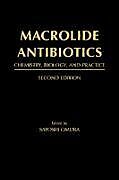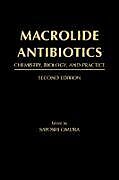Macrolide Antibiotics
Einband:
Fester Einband
EAN:
9780125264518
Untertitel:
Chemistry, Biology, and Practice
Herausgeber:
Elsevier Science & Technology
Auflage:
2. Aufl.
Anzahl Seiten:
635
Erscheinungsdatum:
2002
ISBN:
978-0-12-526451-8
Macrolide Antibiotics: Chemistry, Biochemistry, and Practice, Second Edition explores the discovery of new macrolide antibiotics, their function, and their clinical use in diseases such as cancer, AIDS, cystic fibrosis and pneumonia. This book discusses the creation of synthetic macrolides and the mechanisms of antibiotic activity. The uses for antimicrobial macrolides in clinical practice are also covered. This book is designed to appeal to both the basic and applied research communities interested in microbiology, bacteriology, and antibiotic/antifungal research and treament.
Zusammenfassung
Macrolide Antibiotics: Chemistry, Biochemistry, and Practice, Second Edition explores the discovery of new macrolide antibiotics, their function, and their clinical use in diseases such as cancer, AIDS, cystic fibrosis and pneumonia. This book discusses the creation of synthetic macrolides and the
Inhalt
Contributors
Preface
1. Discovery of New Macrolides
I. Introduction
II. Macrolides from Actinomycetes
III. Macrolides from Bacteria Including Myxobacteria
IV. Macrolides from Fungi
V. Macrolides from Plants and Lichens
VI. Macrolides from Insects
VII. Other Macrolides
VIII. Concluding Remarks
References
2. Discovery of New Macrolides from Marine Organisms
I. Introduction
II. Macrocyclic Lactones of Marine Organism Origin
III. Concluding Remarks
References
3. Chemical Modification of Macrolides
I. Introduction
II. Fourteen-Membered Macrolides
III. Sixteen-Membered Macrolide Antibiotics and the Avermectin Family
IV. Concluding Remarks
References
4. Total Synthesis of Macrolides
I. Introduction
II. Synthetic Strategy for Macrolide Synthesis
III. Total Synthesis of Selected Macrolides
IV. Concluding Remarks
References
5. Biosynthesis, Regulation, and Genetics of Macrolide Production
I. Introduction
II. Reaction Mechanism of Polyketide Biosynthesis
III. Polyketide Synthase
IV. Genes Encoding Modular Polyketide Synthase
V. Sugar Biosynthesis
VI. Genetic Manipulation of PKS Genes
References
6. Pharmacokinetics and Metabolism of Macrolides
I. Introduction
II. Pharmacokinetics and Metabolism
III. Drug Interaction
IV. Concluding Remarks
References
7. Antimicrobial Macrolides in Clinical Practice
I. Introduction
II. Fourteen- and Fifteen-Membered Macrolides
III. Sixteen-Membered Macrolides
IV. Concluding Remarks
References
8. Ivermectin in Clinical Practice
I. Introduction
II. Novel Activity of Ivermectin in Clinical Practice
III. Concluding Remarks
References
9. Tacrolimus and Other Immunosuppressive Macrolides in Clinical Practice
I. Introduction
II. Tacrolimus, a Brief Developmental History
III. Novel Activity of Tacrolimus and Other Immunosuppressive Macrolides in Clinical Practice
IV. Concluding Remarks
References
10. Mode of Action and Resistance Mechanisms of Antimicrobial Macrolides
I. Introduction
II. Mode of Action of Macrolide Antibiotics
III. Mechanisms of Resistance to Antimicrobial Macrolides
IV. Important Developments in Macrolide Antibiotics
V. Concluding Remarks
VI. Addendum
References
11. Mode of Action of Macrolides with Motilin Agonistic Activity--Motilides
I. Introduction
II. Mode of Action of Motilin
III. Invention of Motilides
IV. BiologicalActivity of Motilides
V. Clinical Trials of Motilides
VI. Concluding Remarks
References
12. Novel Activity of Erythromycin and Its Derivatives
I. Erythromycin Treatment in Diffuse Panbronchiolitis
II. Inhibition of Chloride Channel
III. Effects of Macrolides on Cytokine/Chemokine Expression
IV. Modulation of Bacterial Function
V. New Challenge for Novel Action
References
13. Mode of Action of Avermectin
I. Introduction
II. Target of Avermectin Action
III. Cloning and Structure of Avermectin Binding Protein
IV. Concluding Remarks
References
14. Mode of Action of FK506 and Rapamycin
I. Introduction
II. Initial Cellular Target for FK506 and Rapamycin; Peptidyl Prolylcis-trans Isomerases (Rotamases, Immunophilins)
III. Target of FK506-FKBP12 Complex: Calcineurin
IV. Target of Rapamycin-FKBP12 Complex: mTOR/FRAP/RFAT
V. Intervention of Intracellular Signaling Pathways by FK506 and Rapamycin
References
Index

Leider konnten wir für diesen Artikel keine Preise ermitteln ...
billigbuch.ch sucht jetzt für Sie die besten Angebote ...
Die aktuellen Verkaufspreise von 6 Onlineshops werden in Realtime abgefragt.
Sie können das gewünschte Produkt anschliessend direkt beim Anbieter Ihrer Wahl bestellen.
Loading...
Die aktuellen Verkaufspreise von 6 Onlineshops werden in Realtime abgefragt.
Sie können das gewünschte Produkt anschliessend direkt beim Anbieter Ihrer Wahl bestellen.
| # | Onlineshop | Preis CHF | Versand CHF | Total CHF | ||
|---|---|---|---|---|---|---|
| 1 | Seller | 0.00 | 0.00 | 0.00 |
